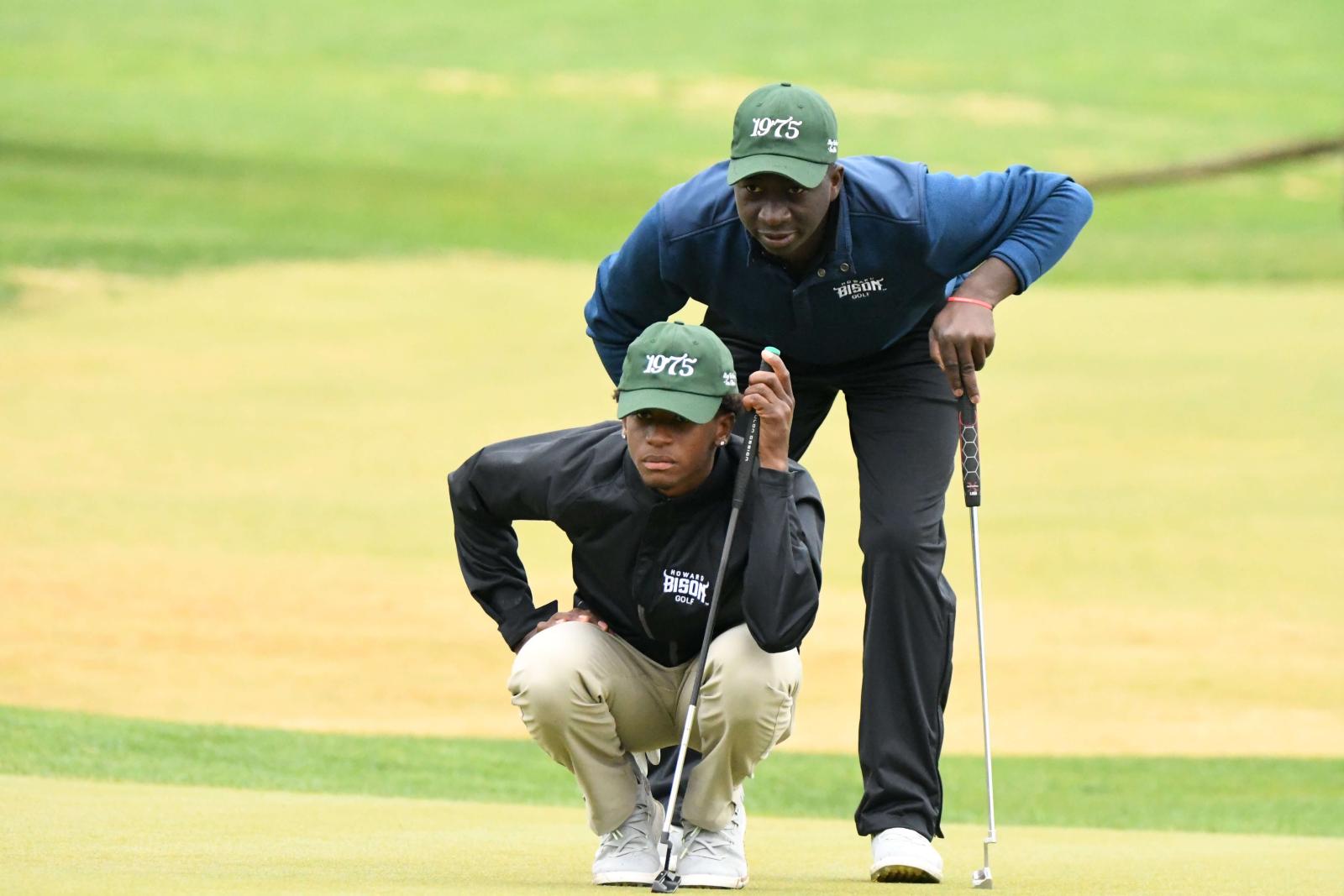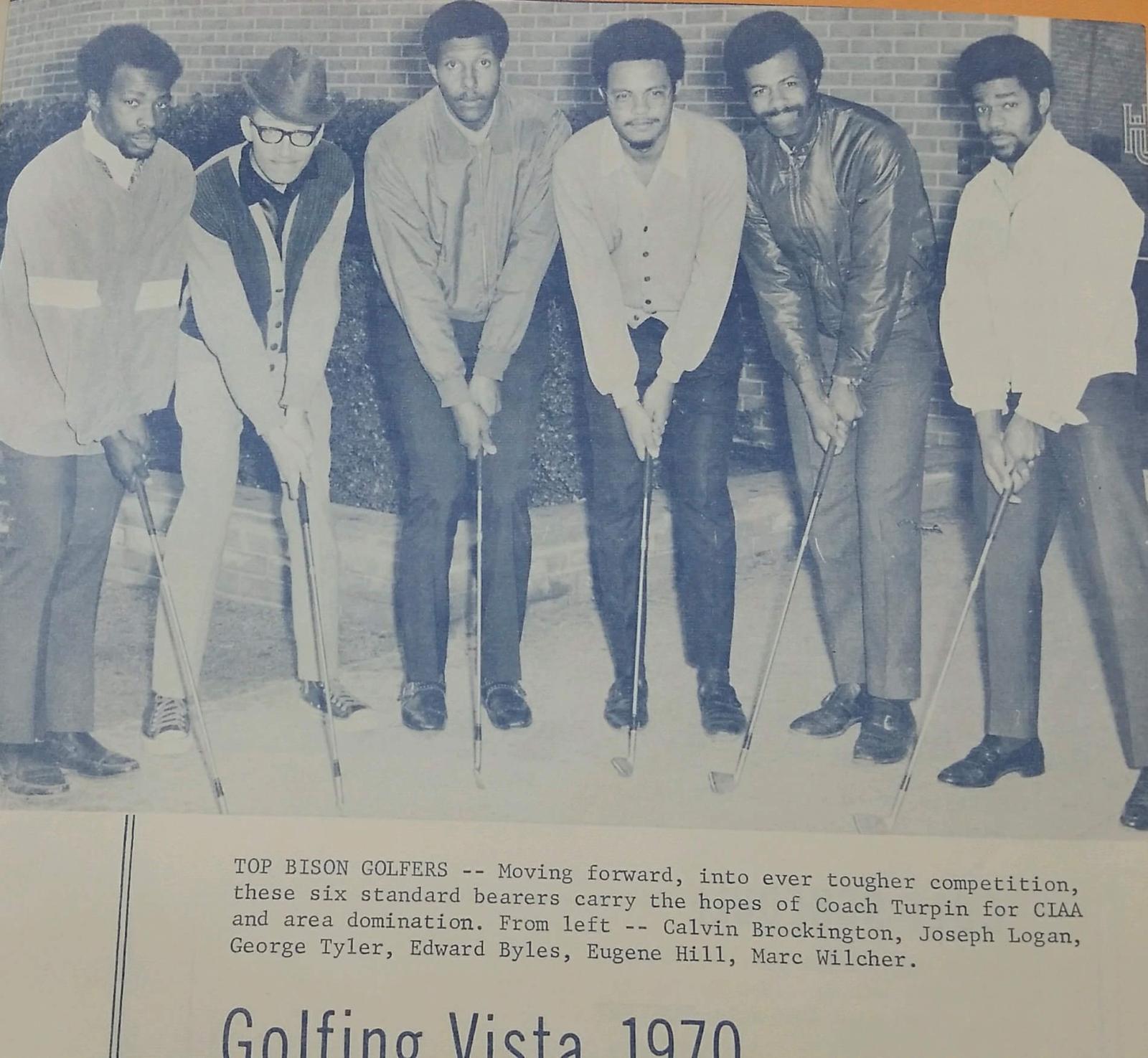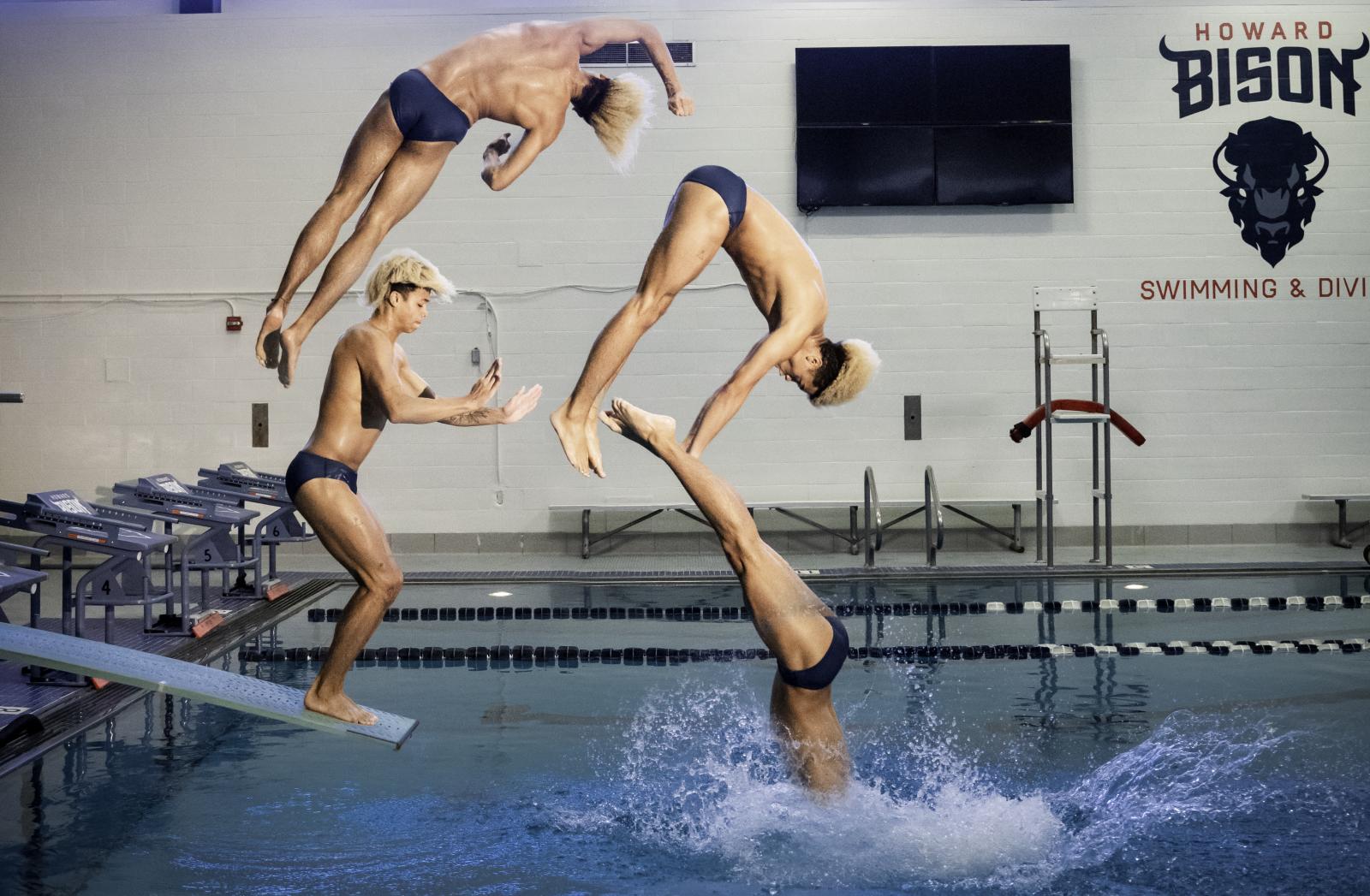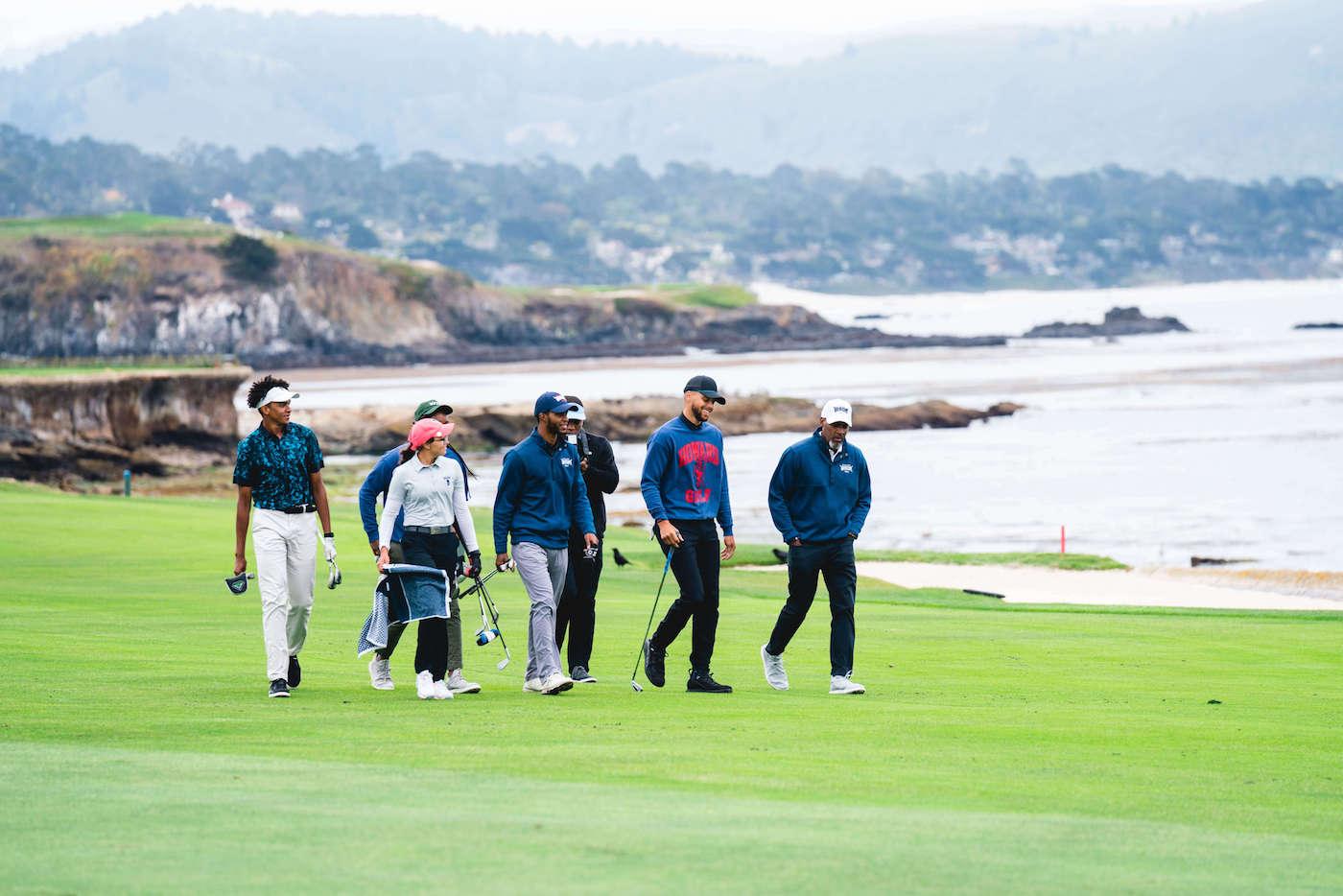By Winter 2021, Howard University had its first Division I men’s and women’s golf teams. They had funding: a seven-figure gift provided by NBA player Stephen Curry that would sustain the program for six seasons. They had a head coach: Samuel G. Puryear Jr. was hired to lead both teams in April 2020. They had players: six on the men’s team and five on the women’s team. They had equipment: Howard-branded golf bags and Bison-emblazoned golf apparel.

However, both teams’ seasons had been postponed because of the coronavirus pandemic – the men’s to Spring 2021 and the women’s to Fall 2021. But the challenges introduced to their competitive schedule did not stop the teams from proudly representing the University when they took to the course to hone their games.
“People actually don’t know a lot about Howard at all,” says Morgan Taylor, a sophomore math major and secondary education minor from Ellicott City, Maryland. Even though the women’s team couldn’t be together during the Spring 2021 semester, she still carried around her Howard golf bag as she went out to the course to practice. She would regularly field questions from the other golfers on the course about Howard, providing her an opportunity to talk about “what Howard stands for.”
“We’re ambassadors for sure,” says Everett Whiten, a junior marketing major from Chesapeake, Virginia. “Being able to represent one of the best HBCUs when we go out to the golf course is a great thing.”
Even during its abridged inaugural season, the. men’s team was able to showcase how Howard’s devotion to excellence translates to the game of golf in going 3-0 in head-to-head team competitions, earning victories over the Naval Academy and Georgetown University. In the MEAC (Middle Eastern Athletic Conference) Championship, the team had an impressive showing, taking a lead into the final day of the tournament before settling for a third-place finish. And in the final tournament of the season, the PGA (Professional Golf Association) Works Collegiate Championships, Howard golfer Gregory Odom Jr. won the individual title.
“We are incredibly enthused by where the program sits today,” says Kery Davis, Howard University athletic director. “We look forward to a bright future for both our men’s and women’s teams.”
Know Your History

During practice rounds and competitions, coach Puryear made sure the men’s team focused on golf. But off the course, he made sure they understood the history of the sport in the African-American community.
“A lot of today’s young people are really far removed from a lot of the old great pros back in the day,” he says. “If you don’t know your history, you’re not going to be able to carve out the future you’re interested in.”
Puryear wanted to ensure his golfers understood just how difficult it was for African-Americans in the generations before them to be granted access to golf courses and find opportunities to play. Barred from most courses because of the color of their skin, Black golfers were only permitted to caddy for other players, not to play themselves.
In the first half of the 20th century, African-American communities built their own courses, though they often lacked the same resources as all-white courses. It wasn’t until 1961 that the PGA tour lifted the “Caucasian-only” clause from its bylaws. Even today, only 3 percent of recreational golfers in the U.S. are African-American. On the PGA tour, there are only three Black men and one Black woman, according to a National Golf Foundation 2019 report.
“If you really understand that struggle,” Puryear says, “you will have a huge appreciation and a high level of gratitude for having access to a lot of these golf courses.”
Puryear would often tell his players stories about the “old pros,” African-American golfers who either played on the all-Black golf circuit or who helped to desegregate professional golf. On one car ride with the team, Puryear called James Black, one of the first Black golfers to play on the PGA tour. Puryear put Black on speaker phone so he could talk to the players about his experience as an African-American in the sport of golf and offer his advice for the young Black players today.
“I think [knowing] the history of the game is very important. [Otherwise], you can really take [all that we have] for granted,” Whiten says. He appreciated the opportunity to speak to Black and hear stories about the African-American legends in golf. “That was somebody who paved the way for us.”
Standing Up When You Stand Out
Despite the many benefits Howard golfers enjoy by playing today – access to top-tier courses and high-quality equipment among others – they are accustomed to feeling uncomfortable on the golf course.
“Growing up, on my [golf] teams and at my tournaments, I was the only [Black person] out there,” Whiten says, who transferred to Howard in Fall 2020 from Hampton University, where he also played on the golf team. Competing at historically Black colleges and universities (HBCUs) has been a critical part of his collegiate golf experience. “I really love being on all Black teams . . . . It gives me a greater joy to be amongst people [who] look like me.”

Hearing the stories of the discrimination faced by Black golfers inspired Howard’s student-athletes to work even harder – so they could succeed themselves and provide greater opportunities for the Black golfers who would come after them.
“I’d love to be that role model for Black golfers in generations to come so that they can see me on the tour and say to themselves, ‘That girl can do it; so can I,” Taylor says. She aspires to play on the LPGA tour and to start a golf academy that would provide resources for underprivileged and underrepresented individuals to learn how to play the sport. “I want to inspire [other Black people] to grind and love the game as much as I do.”
Whenever Edrine Okung, a senior computer information systems major from Uganda, steps onto the course, he always keeps in mind the people who might be looking up to him. “When I’m playing golf, I’m representing a big community who are going to be inspired when they see me advance to a top level,” he says.
Howard’s golfers are working to dispel the lingering belief that golf is a “white man’s game.” In their minds, it’s a vital endeavor for reasons that extend far beyond the world of golf.
A Game of Connections
Getting Howard students onto the golf course was always about more than sports. Practice rounds at the golf course were important opportunities for the players to hone their short game and fine tune their putting. But they were also able to meet and make connections with a wide range of people.
“That’s been the most important part with this opportunity,” Taylor says. “I’ve been able to network with people that I probably would have never been able to meet.” She met executives from Callaway Golf company, Disney and more. Okung did an internship with Callaway Golf the Summer after the first season.
During one practice round of golf, the Howard athletes were paired with non-Howard players, including business owners and members of the community. Whiten and some of the other members of the team even met President Barack Obama on the chipping green before a practice round.
“I want to let our students have access to entrepreneurs and champions of business,” Davis says, “giving them an opportunity [to be seen as] the best and the brightest future leaders in this country. Sometimes, the only thing that stands between a student having an opportunity is access.”
With their Howard University golf bags and gear, they talk to people on the course about Howard and HBCUs. They talk about the history of the game of golf and what the Black “old pros” had to deal with just to play. They showcase the best of the African-American community and the levels of excellence Black individuals can attain when given an opportunity.
“Our students [are] ambassadors for the sport in underrepresented areas,” Davis says. “[Howard] accepts the challenge of being a banner institution.”
Illuminating Howard Golf’s Illustrious Past
As Howard golf enjoys prominence on campus once again, today’s teams have a chance to excel in honor of those who came before them who didn’t have the same opportunities.
Howard’s first men’s golf team was formed in 1958. The Division I category wasn’t created until 1973, but that doesn’t mean Howard’s early golf teams were not high-level competitors. In fact, in the late ’60s and early ’70s, the team was one of the best to compete in the Central Intercollegiate Athletic Association (CIAA). In 1969 and 1970, the men’s team won back-to-back CIAA championships, and one of its golfers, Calvin Brockington, was named MVP of the conference in both seasons.

“They had unbelievable success,” says Paul Cotton, a former Howard wrestling coach, a former member of the Board of Trustees and a bit of an amateur Howard historian.
Women’s golf only existed as club teams and classes; it wasn’t until Title IX legislation passed in 1972 that more emphasis was placed on female athletics.
When Howard joined the Mid-Eastern Athletic Conference (MEAC) in the 1970s, there were budget restrictions that limited the number of sports at affiliated universities. As a result, the first iteration of a men’s Howard golf team disbanded in 1975. It wasn’t until 2014 that the MEAC reinstated golf.
But the 45-year absence of golf at Howard shouldn’t obscure what the golfers were able to accomplish representing the University and what they could have achieved had they played in a different era.
“We had multiple folks that may have had the skill set [to play professionally],” Cotton says about the Howard golfers in the ’60s and ’70s. “But they didn’t have the resources [to make it].”
Article ID: 151




